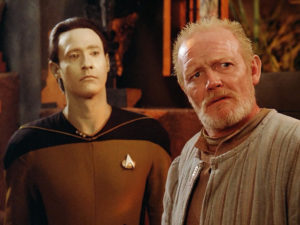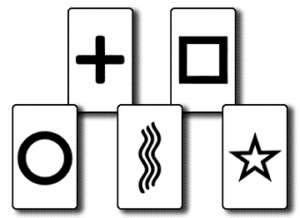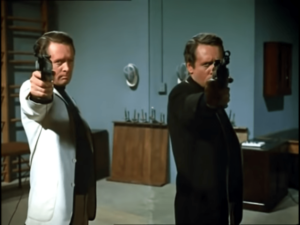
Rewind & Rewatch: The Prisoner – The Schizoid Man

I will start the fifth episode rewatch with my prologue from the first episode–as a caveat and introduction. Again, I’ll put this intro into an indented section to make it easier for people who’ve read it to skip it and get to the current episode.
I am starting a Rewind & Rewatch series on The Prisoner (the 1967 British series, created by Patrick McGoohan and George Markstein and starring McGoohan). I’ll be following the DVD episode order throughout this rewatch. In this series, I am merely looking for things of interest to me, ideas I find striking. This series is decidedly not a comprehensive review of The Prisoner, and these are certainly not my final thoughts on the TV series. It’s more like a set of notes. With any good piece of art, one can continually come back to it and find fecundity: missed elements, new relevancies, new avenues for thought. And, of course, there is already quite a bit of media surrounding the series, e.g., Time for Cakes and Ale has a separate podcast (“The Tally Ho”) reviewing the episodes, there is a fantastic website dedicated to the show (The Unmutal Website, which has articles and links to more writing about the show)–and, of course, there are numerous pop culture references to it. Despite all of this great content, I still feel compelled (for the sheer love of the show) to demonstrate my deficiencies! So, here we go…
I must start with a pop culture reference to this episode from Star Trek: TNG. “The Schizoid Man” is also the name of the sixth episode of season 2 of Star Trek: TNG. It is a direct reference to The Prisoner (McGoohan was supposed to play the character of Dr. Ira Graves). In the TNG episode, Dr. Graves transfers his mind into Data to cheat death. The Prisoner episode deals with the attempt to make Number 6 believe he is someone else–to “fracture” his personality. Of course, for the actual definitions and parameters of Schizoid personality disorder (SPD or SzPD), one should consult proper medical sources (e.g., one could look to the current edition of the DSM).

We begin the episode with the Zener cards and the ESP test with Number 24, who gets a 17 out of 25, a very high probability. According to Michael Shermer, one could expect the following probabilities in guessing:

PROBABILITY predicts these test results for a test of 25 questions with five possible answers if chance is operating:
Most people (79%) will get between 3 and 7 correct (probability is a more precise calculation).
The probability of guessing 8 or more correctly is 10.9% (in a group of 25, you can always expect several scores in this range purely by chance.)
The chances of getting 15 correct is about 1 in 90,000.
Guessing 20 out of 25 has a probability of about 1 in 5 billion.
Guessing all 25 correct has a chance of (.2) = 3.3 x 10, or about 1 in 300 quadrillion! (A wager against such an unusual occurrence would be a safe bet)
(“Deviations: A Skeptical Investigation of Edgar Cayce’s Association for Research and Enlightenment,” Michael Shermer, Skeptic, August 3., 2011, https://www.skeptic.com/eskeptic/11-08-03/#feature).
The history of the Zener cards began with the Rhines:
In America, serious research on psi began with the card-guessing studies of John Cooper and Joseph Banks Rhine and his wife Louisa Rhine…The Rhines were skeptical of the popular mediums of the day and chose a different path of investigation…Rhine began his research into ESP in 1930 with the help of his colleague, Carl Zener. Quickly the use of traditional cards was discarded (the images were too complicated), and Zener developed a deck of 25 cards in which each card had one of five simple symbols: a star, cross, circle, wavy lines, and square. In a guessing experiment, by chance one would correctly pick 5 out of the 25. Rhine’s first experiments were the most successful. Here the experimenter and subject would sit at opposite ends of a table, separated by a thin partition so that the subject could not see the cards. In a telepathy experiment, the experimenter would look at a card which the subject would try to guess. For clairvoyance, the experimenter would not look at the cards, but simply pick one up (face down) and the subject would again guess. For precognition, a subject would write down ahead of time the order in which cards would be selected from a shuffled deck. By 1934, Rhine had amassed nearly 100,000 attempts, averaging 7.1 correct identifications per run, higher than the 5 hits one would expect from chance. With great enthusiasm, Rhine announced to the world that he had finally made a world-changing discovery, a scientific demonstration of psi phenomena (Rhine, 1934). Today, researchers discount the first decade of Rhine’s work with Zener cards. Stimulus leakage or cheating could account for all of his findings. Slight indentations on the backs of cards revealed the symbols embossed on card faces. Subjects could see and hear the experimenter, and note subtle but revealing facial expressions or changes in breathing. The psi effect would mysteriously disappear whenever a magician was present in the Rhine laboratory. In the face of Rhine’s initial failures, psi researchers had three options: replicate, rationalize, or cheat (Pseudoscience and Extraordinary Claims of the Paranormal: A Critical Thinker’s Toolkit, Jonathan C. Smith, Wiley-Blackwell, 2010, 248-250).
This use of the Zener cards sets up a foreshadow of the episode for the viewer: stimulus leakage or cheating is a clue to The Village’s modus operandi; and we, too, can see and hear the experimenter, through facial expressions and other means, giving us clues to the actual design behind the methods. Though, the episode construct wants us to believe in the reality of cards, or maybe more accurately wants us to believe that Number 6 believes in the reality of the cards–the “mental link” shared by Number 6 and Number 24 is real within the episode, but it becomes clear that the “mental link” is supposed to be a created one, i.e., in the sense of unconscious cues. For by the end of the episode, there is a bit more explanation (e.g., a book on Number 24’s table, the mind reader, and a conversation between Number 24 and Number 6 that gives us more clarity on the issue).
Next, we see Number 6 in the stereo-type/trope of the “evil twin”–the mustache. However, here the trope is flipped: Number 6, our hero, is the “bad guy,” and now he is Number 12. Of course, our protagonist is suspicious of his new designation, despite The Village’s attempts to normalize it. The double ruse is on: Number 2 tells Number 6 his plan while pretending that Number 6 is Number 12. So, can they fool Number 6 into thinking they think he is Number 12? Or perhaps can they fool Number 6 into thinking he is Number 12? Either might serve their purposes–viz., confusion and break down.

Number 24 is called in by Number 6 to help settle the problem. She identifies the fake Number 6 as the real one through their “mental connection.” The plan appears to be working; Number 6 is having doubts, at least subconsciously (for his dreams betray this anxiety). But soon, of course, our protagonist begins to see the deception–he literally shocks himself back to reality.
This episode is, among other things, a play on the classic doppelganger story, the shadow person, who is and is not us. We doubt and ask ourselves, “Who am I?” just as Number 6 does. Here, though, Number 6 has security in who he is–he always seems to come back despite the deceptions; his strength of self shines through. And the doppelganger is “real,” in the sense of not being a psychological projection or a paranormal entity. But it is also not “real,” in the sense that it is merely another man pretending to be Number 6 and not a psychological projection or a paranormal entity. The episode gets to play with both ideas, however–i.e., the psychology of the doppelganger and the trope of the double agent. Both of these play true to form: they are harbingers of death. In myth, a vision of one’s doppelganger can prefigure death, and, of course, in spy drama, one or the other of the doubles typically has to die. Here, the fake double dies. But, also, Number 6’s chance at escape dies. Furthermore, his ignorance of a specific death betrays him: just as he is about to leave The Village, Number 2 asks a question about his wife which he gets wrong; Number 2 reveals that Number 12’s wife died a year previously, thwarting Number 6’s chance at freedom.
Thanks for reading–and I’ll be back soon to continue my rewatch of The Prisoner. “Be seeing you”…



